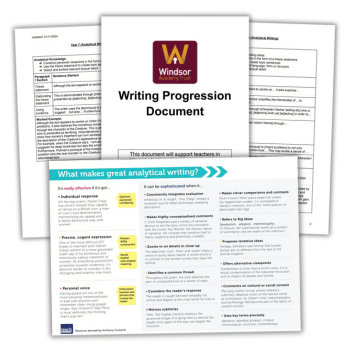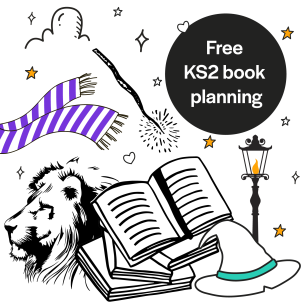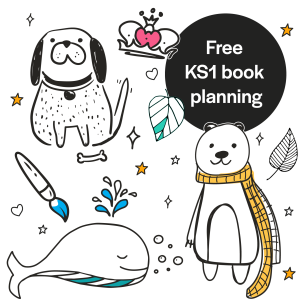Analytical writing progression document
This analytical writing progression document from Gaurav Dubay and Windsor Academy Trust outlines the expected development of analytical writing skills from Year 7 to Year 11.
It provides guidance for teachers to help students refine their analytical writing, focusing on structuring arguments, embedding textual evidence and evaluating the writer’s intent.
Throughout the document, analytical writing is scaffolded with structured paragraph guidance, sentence starters and worked examples.
This ensures students build confidence and fluency in their analytical writing across different texts and exam requirements.
The document is not prescriptive but offers insights into the knowledge and skills required to write effectively in an analytical manner.
Analytical writing in KS3
Analytical writing in Year 7 begins with constructing a personal viewpoint through a thesis statement, selecting relevant textual details and embedding quotations. Sentence starters and worked examples help students form structured responses.
By Year 8, analytical writing develops with a stronger focus on controlling ideas, analysing language, form and structure, and evaluating the writer’s intent.
As students progress into Year 9, analytical writing incorporates comparative analysis, contextual links and concluding arguments.
Analytical writing in KS4
The document supports GCSE preparation by detailing analytical writing expectations for Language Paper 1 and Paper 2, focusing on both language and structural analysis.
It also guides students on how to construct analytical writing for literature, including Shakespeare, pre-20th-century texts, modern texts and poetry.
Gaurav Dubay is trust director of English and an Evidence Lead in Education.
Analytical writing poster
The poster included in this download, created by Anthony Cockerill, describes the qualities of great analytical writing, in two parts. The first section describes three ways analytical writing can be really effective:
- Individual response
- Precise, cogent expression
- Personal voice
The second part looks at 12 ways you can make your analytical writing even more sophisticated.
How to teach great analytical writing
Teaching great analytical writing means going beyond predictable frameworks to draw out more personal, considered responses, says Anthony Cockerill…
I’m not sure I always taught analytical writing well early in my teaching career. For me, like many, the PEE paragraph (along with its errant siblings PEEL and PEAZLE) was a handy formula to get students through coursework essays and to use as a model for exam-style responses; a way to capture thinking and a method of scaffolding a potentially difficult process.
However, in my reliance on it, I don’t think I was teaching the essence of good analysis. When I started to consider this more deeply, I decided that I need to find a more engaging and effective approach – so I planned to work with my students to establish some maxims for great analytical writing; arguably the primary way of responding to texts and ideas in the real world, in the media, in politics, in society and in culture.
Individual opinion
I began by making sure that the students really understood what analysis actually is. By exploring a range of real-world examples, I reasoned, we could begin to deconstruct the elements of analysis through classroom discussion.
I screened a clip from an episode of Top Gear, in which Jeremy Clarkson road-tests the Ferrari F12.
“Thanks to a 730 horsepower V12, it’s the most powerful road going Ferrari ever made…” says Clarkson.
“What exactly is he doing here?” I ask the students. No response. “Referring to specific details,” I suggest. “Commenting on significance.”
“It’s almost as powerful, in fact, as Fernando Alonso’s Formula One racer,” continues Clarkson.
“See how Jeremy makes connections and comparisons with other things,” I explain. “On Top Gear, the tone of the analysis is fairly informal, but the elements are just the same as they would be in more formal analytical writing.”
‘This is light and nimble and sharp… it is… spectacular,’ concludes Clarkson.
‘Say what you like about Jeremy Clarkson,’ I say, ‘but it’s clear that he has an opinion.’ This becomes our first mainstay of analytical writing: individual response.
Precise and cogent
We then read a column by The Observer restaurant critic Jay Rayner, who with typical flair, describes ‘an impeccably seasoned disc of steak tartare, full of softness and just the right amount of acidity and piquancy, topped with the sunshine promise of an egg yolk.’
‘What does ‘impeccably seasoned’ suggest about the cooking?’ I ask.
‘It’s been done well. Masterfully seasoned, in fact!’ a student offers.
I pose a question: ‘Why ‘sunshine promise’?’
‘The egg yolk is bright?’ suggests the student.
‘But what else does ‘sunshine’ imply?’
‘It’s really positive and upbeat,’ says the student.
We establish that precise, cogent expression is a crucial part of analytical writing; our second key element.
Just as Jay Rayner conveys the restaurant’s attention to detail through his language, our choices of words can convey our understanding of what we’re analysing with clarity and discernment, helping us to consider deeper layers of meaning and nuances.
Personal touch
I wanted to focus on the idea of personal voice in analytical writing — what we considered to be the third foundational element — and alongside it, the idea that tone can vary, depending on the context of the writing.
I decided my students should write analytically about something either media-based or a ‘text’ from popular culture in order to liberate them initially from a more formal tone in which they might struggle to express their personal voice.
To model this process, I chose the video for Katy Perry’s song ‘California Gurls’. We watched it in class, making notes and exploring screenshots. We considered what the video was aiming to achieve and how media language had been appropriated to this end.
I then modelled the writing of a piece of more informal analytical writing, which eventually took the shape of a media-style review.
I asked students what they made of my opening sentence: ‘Having pulled off one of the most amazing metamorphoses in pop (can anyone even remember clean-living Gospel singer, Katy Hudson?), Katy Perry is definitely the thinking person’s pop tart.’
One student said, ‘I like the informality of the bit in brackets.’ I suggest that the parentheses help me to speak to my reader and to inject a little personality into the text, which the student agrees with, although there are several groans at the ‘pop tart’ gag.
Students then chose a subject of their own to write about. These ranged from the ‘shower scene’ in Psycho to Family Guy; from Radiohead’s OK Computer to the work of the German industrial metal band Rammstein.
Next steps
Results were pleasing. The students’ responses immediately felt more individual and their voices more personal. They began to evaluate in a way they hadn’t done before.
Through the choices they made about grammar and sentence structure – and the discussions we had around these things – precision and cogency began to characterise their writing in ways for which for the PEE paragraph had never allowed.
In order to prepare the ground for our next steps, we read Carol Rumens’ analysis of Richard Blanco’s presidential inauguration poem, One Today.
Exploring the text together, we thought about how the three key elements we established are present in Rumens’ writing, but how the relative formality of the piece means that they’re present in perhaps different ways.
There’s still work to be done. But by acknowledging the limitations of the PEE paragraph and allowing the students to become engaged by genuine personal response, we feel we have begun a process that feels perfectly matched to our vision for an engaging, diverse and rich curriculum in which young people are apprentices in the discipline of writing.
And students and teachers are all the better off for it.
The 3 key elements of analytical writing
- Individual response
Make the process of generating ideas very explicit in classroom discussion. Yes, when reading literature, we can assent to or challenge the critical orthodoxy, but encouraging students to think for themselves and become proficient at forming opinions is crucial. - Precise, cogent expression
When paraphrasing a text or describing aspects of it, encourage students to experiment with language and refine what they’re trying to say. This can be done through teacher-led work – modelling how to cull redundant words or how to choose more precise ones – and students can work in pairs, practising the process themselves. - Personal voice
Perhaps the trickiest of the three, but starting with informal analytical writing is a fun and irreverent way of guiding students toward finding their voice. Once the idea of writing in a particular tone is established, students can then explore how to capture a more authoritative tone in more formal contexts.
Anthony Cockerill is Head of English at Boroughbridge High School, North Yorkshire. Find him at anthonycockerill.com and follow him on Twitter at @thecockerill. Download our free Macbeth essay two-lesson resource pack.











